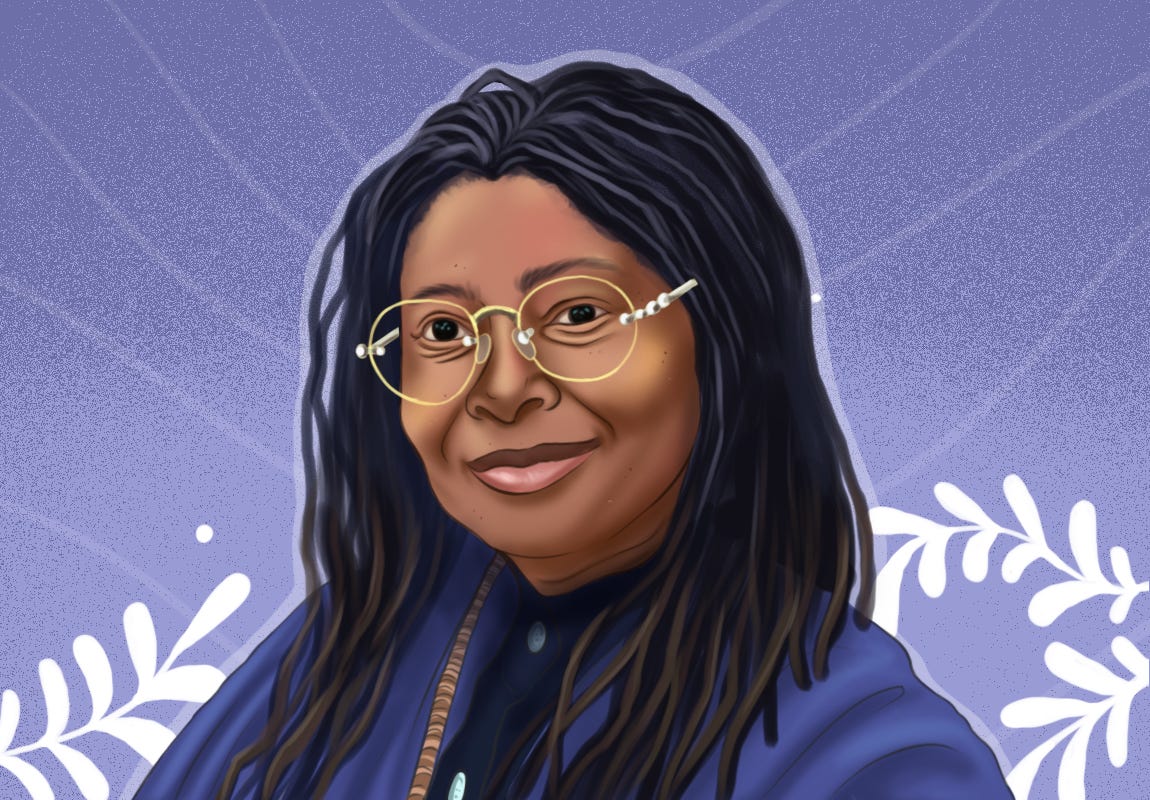Alice Malsenior Walker, American writer and social activist, is known for her novels, short stories, and poems, noted for their insightful treatment of African American culture.
Alice was born on February 9, 1944, in Eatonton, Georgia, the United States. She was the eighth and the youngest child of sharecropper parents. She grew up poor with her mother working as a maid to support the family.
When she was eight years old, Alice was accidently blinded in one eye. According to History.com, she was shot in the right eye with a BB pellet while playing with two of her brothers. Whitish scar tissue formed in her damaged eye. She became self-conscious of the visible mark. After the incident, Alice withdrew from the world around her. Her mother gave her a typewriter, allowing her to write instead of doing chores.
In an interview with American author John O’Brien, which was published in Alice Walker: Critical Perspectives, Past and Present (1993), she said: “For a long time, I thought I was very ugly and disfigured. This made me shy and timid, and I often reacted to insults and slights that were not intended.” She found comfort in reading and writing poetry.
Alice, a bright student, graduated from high school as a class valedictorian. Her academic excellence earned her a scholarship to attend Spelman College in Atlanta, Georgia, where she studied for two years before transferring into Sarah Lawrence College in New York. She began to work seriously on writing poems, publishing several in the college journal. While studying in Sarah Lawrence, Alice visited Africa as a part of a study-abroad programme. She graduated in 1965, and, in the same year, published her first short story.
After graduation, Alice moved to Mississippi and took part in the civil rights movement. During this time, she met and married Melvyn Leventhal, a Jewish civil-rights lawyer. The two became the only legally married interracial couple living in Jackson, Mississippi. They divorced in 1976.
Alice’s first book of poetry, Once, was published in 1968. Two years later, in 1970, she published her first novel, The Third Life of Grange Copeland, a narrative that spans 60 years and three generations. In 1973, she published her second volume of poetry, Revolutionary Petunias and Other Poems, and her first collection of short stories, In Love and Trouble: Stories of Black Woman.
The Colour Purple became a best seller and won the Pulitzer Prize for Fiction and the National Book Award for fiction in 1983.
In Love and Trouble: Stories of Black Woman talks about the sexist violence and abuse faced by the African American community. After moving to New York, in 1976, Alice completed Meridian, a novel describing the coming of age of several civil rights workers in the 1960s.
After spending some years in New York, she moved to California. In 1982, Alice Walker published her most popular novel, The Colour Purple. It was an epistolary novel that depicted the growing up and self-realisation of an African American woman between 1909 and 1947 in a town in Georgia. The novel explores the female African American experience through the life and struggles of its narrator, Celie, who faces terrible abuse at the hands of her father and later from her husband.
The Colour Purple became a best seller and won the Pulitzer Prize for Fiction and the National Book Award for fiction in 1983. The novel was adapted into a film in 1985 by Steven Spielberg, starring Whoopi Goldberg as Celie, and Oprah Winfrey and Danny Glover. Like the novel, the movie was a critical success, bagging 11 Academy Award nominations.
Alice Walker explored her own feelings about the film in her 1996 work, The Same River Twice: Honoring the Difficult. A musical version of The Colour Purple, produced by Oprah Winfrey and Quincy Johns, was premiered in 2004.
Alice Walker’s later fiction includes The Temple of My Familiar, an examination of racial and sexual tensions (1989); Possessing the Secret of Joy (1992), a narrative centred on female genital mutilation; By the Light of My Father’s Smile (1998), the story of a family of anthropologists posing as missionaries in order to gain access to a Mexican tribe; and Now Is the Time to Open Your Heart (2005), which was about an older woman’s quest for identity. According to Britannica, even though she was criticised by reviewers for New Age abstractions and poorly conceived characters, Alice Walker continued to receive praise for championing racial and gender equality in her work.
She also released the volume of short stories, The Way Forward Is with a Broken Heart (2000), and several other volumes of poetry, including Absolute Trust in the Goodness of the Earth (2003), A Poem Traveled Down My Arm (2003), Hard Times Require Furious Dancing (2010), and Taking the Arrow Out of the Heart (2018). Her Blue Body Everything We Know: Earthling Poems (1991) is a collection of poems from 1965 to 1990.
Alice Walker’s essays were compiled in In Search of Our Mother’s Gardens: Womanist Prose (1983), Sent by Earth: A Message from the Grandmother Spirit After the Bombing of the World Trade Center and Pentagon (2001), We Are the Ones We Have Been Waiting For (2006), and The Cushion in the Road: Meditation and Wandering as the Whole World Awakens to Being in Harm’s Way (2013).
The documentary, Alice Walker: Beauty in Truth, was released in 2013.
Alice Walker coined the term ‘womanist’ to describe her philosophical stance on the issue of gender. As a womanist, she saw herself as someone who appreciates women’s culture and femininity. Her works often reflect this stance as well as the universality of human experience. Almost all of her central characters are black women.
Alice Walker, according to American feminist and political activist Gloria Steinem, “comes at universality through the path of an American black woman’s experience … She speaks the female experience more powerfully for being able to pursue it across boundaries of race and class.”
Now put on your thinking hats and think about the following questions for a couple of minutes.
Can you think of why the book The Colour Purple is regarded as Alice Walker’s magnum opus?
How would you describe the contributions of Alice Walker in the fight for racial and gender equality?
Write down your thoughts and discuss them with your students, children and your colleagues. Listen to their views and compare them with your own. As you listen to others, note how similar or different your views are to others’.
Thank you for listening. Subscribe to The Scando Review at thescandoreview.com.
Happy Teaching!













Alice Walker: Author of the powerful novel The Colour Purple